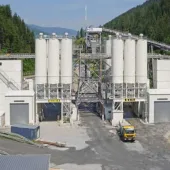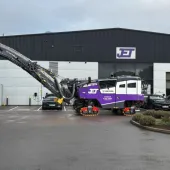Volvo Trucks celebrate 10 years of the FMX

Latest version features entirely new cab, higher payloads and innovative safety features
VOLVO Trucks have recently started selling their toughest ever construction truck – the new Volvo FMX. This is the third version of the FMX and features an entirely new cab, higher payloads and innovative safety features.
With increased front axle loads of up to 20 tonnes and a 38-tonne bogie, the new FMX is built for the most demanding assignments even on very rough terrain. It is also designed for future electric drivelines and certified for the use of HVO, a fossil-free alternative to diesel.
In 2010, Volvo Trucks introduced the first Volvo FMX – a truck specifically developed to meet the demands of the construction industry. Since then it has built a reputation as one of the toughest construction trucks on the market, as a result of the introduction of many innovative features.
The new Volvo FMX is built on an entirely new cab platform, based on the company’s 10 years of experience of delivering robust construction trucks.
‘The new Volvo FMX is designed to deliver a superior combination of agility and durability. Apart from the sturdy design, the new cab with upright A-pillars provides more space and improved visibility. It’s also easier to get in and out,’ explained Helena Alsiö, vice-president of the FM and FMX product line at Volvo Trucks.
With the new Volvo FMX it is easy to go from inter-axle differential lock to full differential lock and back. Simply by turning the new traction-control knob, the driver can tell the truck to automatically synchronize the speed of the wheels before engaging full differential lock. The driver gets clear, instant feedback on the instrument display and can monitor the differential locks in real time.
At speeds below 15km/h, it is possible to change the direction of travel of the truck on the go. After shifting the I-Shift gear selector from drive to reverse, the driver can brake the truck using the accelerator. How fast the truck changes direction is determined by how hard the accelerator is pressed.
‘The option of changing direction on the go is very useful, especially in combination with Volvo Dynamic Steering, when manoeuvring at low speeds in tight places,’ explained Ms Alsiö.
Volvo Dynamic Steering, which was introduced in 2013, is a patented technical innovation that makes it possible to drive a truck with minimal effort. It combines conventional hydraulic power steering with an electronically regulated electric motor fitted to the steering gear.
‘Volvo Dynamic Steering is a great success and perfect for a construction truck. At low speeds, it makes steering effortless and precise, and removes the strain on the driver’s arms and shoulders. This means improved safety and a reduced risk of occupational injuries,’ said Ms Alsiö.
For trucks with a steered tag or pusher axle, the steering angles have been increased, resulting in better manoeuvrability and reduced tyre wear. All these improvements are said to add up to greater productivity and cost efficiencies for construction transport tasks.
The construction version of the leading Volvo I-Shift gearbox allows the Volvo FMX to handle tough and hilly terrain with high levels of productivity and driver comfort. In 2016, Volvo Trucks introduced I-Shift with crawler gears, which allows the truck to pull away from a standstill with very heavy loads. It also allows truck operators to drive at speeds as low as 0.5km/h – a significant help during precision manoeuvring.
The new cab of the new Volvo FMX comes with a number of improvements in driver visibility, including larger windows, a lowered door line and new rear-view mirrors. The visibility can be further improved by the addition of a passenger corner camera that gives a complementary view of the side of the truck in the 9in side display.
The side display can be used to monitor up to eight cameras, four of them simultaneously, giving the driver an easily accessible view of both the truck and the surrounding environment. Additional safety-enhancing features include downhill cruise control, which sets a maximum speed to help prevent unwanted acceleration when travelling downhill.
The Electronically Controlled Brake System (EBS), which is a prerequisite for Collision Warning with Emergency Brake and Electronic Stability Control, is now standard on the new Volvo FMX, whilst Volvo Dynamic Steering, with Lane Keeping Assist and Stability Assist, is available as an option.
In addition, a new road sign recognition system increases safety by displaying traffic signs, such as speed limits, overtaking restrictions and road type, on the instrument display. For very tough applications, such as mining and quarrying, the Volvo FMX has an optional steel roof hatch with an emergency exit handle that removes the entire hatch cover.









